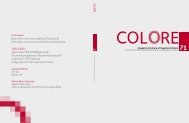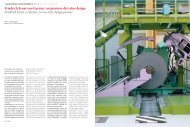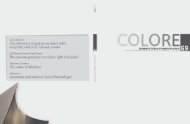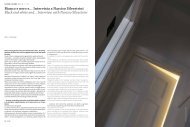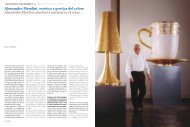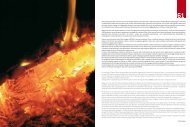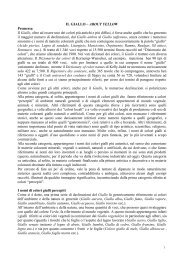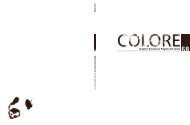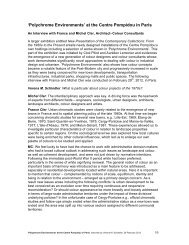Quaderni di Cultura e Progetto del Colore - Istituto Del Colore
Quaderni di Cultura e Progetto del Colore - Istituto Del Colore
Quaderni di Cultura e Progetto del Colore - Istituto Del Colore
You also want an ePaper? Increase the reach of your titles
YUMPU automatically turns print PDFs into web optimized ePapers that Google loves.
CULTURA / CULTURE [ (1 + 2 ) 3 4 5 6 7 8 ]<br />
Vedere è colore: il cielo è blu<br />
Seeing is colour: the sky is blue<br />
<strong>di</strong>/by : Jo<strong>di</strong> L.Sandford 1<br />
sandford@unipg.it<br />
Parole chiave: termini <strong>del</strong> colore, polisemia <strong>del</strong> colore,<br />
metafora concettuale, incarnazione<br />
Key words: color terms, color polysemy, conceptual<br />
metaphor, embo<strong>di</strong>ment<br />
L'articolo originale è stato presentato alla 11th<br />
Congress of the International Color Association<br />
Sydney, (AIC) 2009.<br />
Special thanks to Polly, Michael, and Susan.<br />
SOMMARIO<br />
L’analisi <strong>del</strong>le metafore concettuali <strong>del</strong> colore rivela<br />
mo<strong>del</strong>li <strong>di</strong> percezione, cognizione ed elaborazione<br />
linguistica. Sostengo che, in linea con l’approccio<br />
<strong>del</strong>la linguistica cognitiva, tale mappatura riflette<br />
la motivazione embo<strong>di</strong>ed <strong>del</strong>la doppia significazione<br />
<strong>di</strong> ogni colore, sia come luce sia come materia.<br />
L’ipotesi <strong>di</strong> questo stu<strong>di</strong>o è che la semantica<br />
dei termini <strong>del</strong> colore varia attraverso tre tipologie<br />
<strong>di</strong>stinte <strong>di</strong> metafora concettuale: primaria, sottosistemica<br />
e specifica. Ciò che spesso sembra essere<br />
una manifestazione isolata <strong>del</strong> significato <strong>del</strong><br />
termine <strong>del</strong> colore è invece la constatazione sistematica<br />
<strong>di</strong> queste tipologie <strong>di</strong> metafora concettuale,<br />
che inoltre riflettono aspetti <strong>del</strong>la nostra intrinseca<br />
comprensione <strong>del</strong>le “cose” – I COLORI SONO ENTITA’<br />
o I COLORI SONO LUOGHI – e <strong>del</strong>le “relazioni” – IL<br />
BUONO È COLORE o VEDERE È COLORE.<br />
La categorizzazione <strong>del</strong> colore si elabora attraverso<br />
la co-occorrenza <strong>del</strong>l’allineamento <strong>di</strong> Figura e Sfondo,<br />
attraverso l’interpretazione <strong>di</strong> similarità e <strong>di</strong>fferenza.<br />
La teoria <strong>del</strong>la cognizione incarnata (embo<strong>di</strong>ment)<br />
e la teoria <strong>del</strong>la metafora concettuale sono<br />
para<strong>di</strong>gmi rilevanti per l’analisi su come gli uomini<br />
creino una rete polisemica <strong>di</strong> significati dei termini<br />
<strong>del</strong> colore. Il colore rappresenta un focus cognitivo<br />
nel linguaggio, che attiva alternativamente un’as-<br />
ABSTRACT<br />
Conceptual color metaphor mapping reveals patterns<br />
of perception, cognition, and linguistic elaboration.<br />
I suggest that in keeping with the cognitive<br />
linguistic approach such mapping reflects embo<strong>di</strong>ed<br />
motivation of the double signification of each<br />
color, both as light and as substance. The hypothesis<br />
of this study is that color term semantics ranges<br />
across three <strong>di</strong>stinct types of conceptual metaphor:<br />
primary, sub-systemic and specific level.<br />
What often seems to be an isolated manifestation<br />
of color term meaning is instead a systematic realization<br />
of these conceptual metaphor types, which<br />
in turn reflect aspects of our embo<strong>di</strong>ed comprehension<br />
of things - COLORS ARE ENTITIES or COLORS ARE<br />
LOCATIONS and relations - GOOD IS COLOR or SEEING<br />
IS COLOR.<br />
Color categorization is processed through co-occurrence<br />
of Figure and Ground alignment, through<br />
interpretation of similarity and <strong>di</strong>fference. Embo<strong>di</strong>ment<br />
Theory and Conceptual Metaphor Theory are<br />
relevant para<strong>di</strong>gms for the analysis of how humans<br />
create a polysemic network of color term senses.<br />
Color represents a cognitive focus in language,<br />
which in turn triggers a positive or negative association<br />
with the context. Further research should<br />
shed light on how embo<strong>di</strong>ed color term processing,<br />
sociazione negativa- positiva con il contesto. Ulteriori<br />
analisi dovrebbero mettere in luce come l’elaborazione<br />
visiva incarnata <strong>del</strong> termine <strong>del</strong> colore,<br />
insieme ad altri sensi (oltre quello visivo), metta<br />
in atto il meccanismo cognitivo che permette agli<br />
in<strong>di</strong>vidui <strong>di</strong> formulare una metafora concettuale.<br />
Infine i termini <strong>del</strong> colore sono utilizzati a significare:<br />
“conosco ciò <strong>di</strong> cui parlo, l’ho visto e posso <strong>di</strong>rvi<br />
<strong>di</strong> che colore è.”<br />
INTRODUZIONE- POLISEMIA DEL COLORE E CONNO-<br />
TAZIONI ANTAGONISTE<br />
La polisemia dei Termini Basici <strong>del</strong> <strong>Colore</strong> (TBC) 1<br />
è imme<strong>di</strong>atamente evidente quando osserviamo<br />
come vengono utilizzati nel linguaggio naturale.<br />
Ogni categoria <strong>del</strong> colore è polisemica e permette<br />
connotazioni antagoniste. I TBC posseggono molteplici<br />
significati che sono vincolati all’ associazione<br />
creata dalla relazione oggetto/ contorno, figura/<br />
sfondo. Per esempio, il termine <strong>del</strong> colore ‘blu’ avrà<br />
una connotazione positiva in associazione con il<br />
cielo e l’acqua (cieli blu, acque blu), ed una connotazione<br />
negativa che si basa sulla melanconia<br />
e sulla volgarità (umore blu, film blu). Avrà inoltre<br />
significati iconici, come nel co<strong>di</strong>ce dei colori, ‘primo<br />
premio’ (coccarda blu, che rappresenta l’alta qualità<br />
in inglese, come nastro azzurro in italiano) o nel-<br />
together with other senses, establishes the cognitive<br />
mechanism that allows in<strong>di</strong>viduals to elaborate<br />
conceptual metaphor in general. In the end<br />
color terms are used to imply: “I know what I mean,<br />
I have seen it, and I can tell you what color it is.”<br />
INTRODUCTION COLOR POLYSEMY AND ANTAGONIS-<br />
TIC CONNOTATIONS<br />
The polysemy of Basic Color Terms (BCTs) 1 is imme<strong>di</strong>ately<br />
evident when we observe how they are<br />
used in natural language. Each color category is<br />
polysemic and allows for antagonistic connotations.<br />
BCTs have multiple meanings that are tied<br />
to the association that is made with the object/<br />
surround, figure/ground relation. For example,<br />
the color term ‘blue’ will have a positive connotation<br />
connected with the sky and water (blue skies,<br />
blue waters), and a negative con-notation that is<br />
based on melancholy and profanity (blue mood,<br />
blue movie). It will also have iconic meanings, as<br />
in color co<strong>di</strong>ng, ‘first place’ (blue ribbon) or historic<br />
conventions ‘aristocratic’ and ‘blasphemous’ (blue<br />
blood, blue joke), or when in-<strong>di</strong>cating a specific<br />
type among others that are similar, but <strong>di</strong>fferent<br />
in color or color inference (the blue button, in the<br />
blue lines). ‘Blue’ can also be used to describe skin<br />
color, when lacking in circulation from the cold or<br />
Vedere è colore... / Seeing in colour...<br />
Colors on the horizon 1<br />
Sandford&Gosti - 2009;<br />
scatto <strong>di</strong> performance video sperimento<br />
sul contrasto cromatico, Mutawintji<br />
National Park, NSW, Australia.<br />
Colors on the horizon 1<br />
Sandford&Gosti - 2009;<br />
experimental color contrast performance<br />
shot for video, Mutawintji National Park,<br />
NSW, Australia.<br />
10 COLORE COLORE 11



